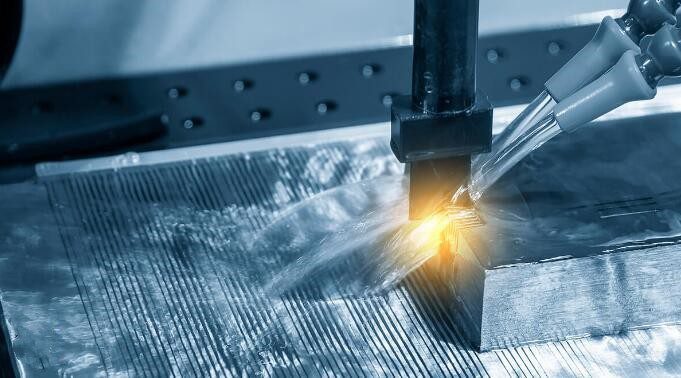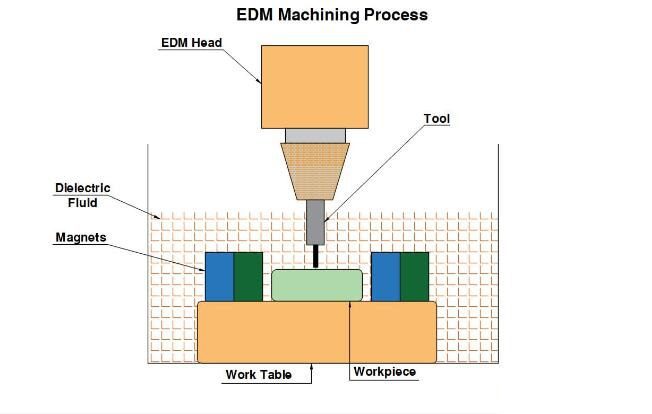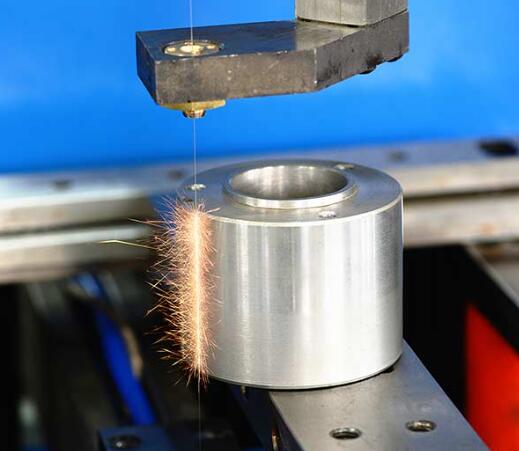Sinker EDM vs Wire EDM Machining Comparison
While both Sinker EDM and Wire EDM processes fall under the umbrella of Electrical Discharge Machining, they differ in several ways. This section aims to provide a detailed comparison between the two, including their method of operation, the materials they can handle, and their most suitable applications.
Method of Operation
Sinker EDM, also known as Ram EDM or Die-Sinker EDM, involves an electrode and workpiece submerged in an insulating liquid like oil or dielectric fluid. The electrode and workpiece do not make physical contact, but a spark is generated through the dielectric fluid, melting and vaporizing a small portion of the workpiece.
Wire EDM, or Wire-Cut EDM, on the other hand, involves a thin wire acting as the electrode. The wire, usually made from brass or stratified copper, is held between two diamond guides and moves in a carefully controlled pattern. As with Sinker EDM, a spark jumps the gap between the wire and the workpiece, but the spark is controlled along the wire path, cutting the workpiece.
Dielectric Liquid
Both Sinker EDM and Wire EDM require the use of a dielectric liquid, which acts as an insulator until the voltage reaches a point where a spark is formed. In Sinker EDM, the workpiece and the electrode are submerged in this dielectric liquid. When the electrical voltage between the electrode and the workpiece overcomes the dielectric fluid’s resistance, a spark jumps across the gap and removes a small piece of the workpiece.
In Wire EDM, the dielectric liquid also cools and lubricates the wire and flushes away the eroded particles. The constant replenishment of fresh dielectric fluid ensures optimal cutting conditions and promotes a higher quality cut.
Materials Used
Both Sinker EDM and Wire EDM can handle a wide range of materials, as long as they are electrically conductive. This includes metals like titanium, aluminum, steel, copper, and many alloys.
However, Sinker EDM is generally more suitable for machining harder metals that are difficult to cut through traditional machining processes. Wire EDM is preferred when the workpiece requires intricate details or fine cuts, especially in the production of stamping dies and molds.
Applications
Sinker EDM is better suited for creating complex shapes and molds, cavities, or intricate patterns, especially when the material is extremely hard or tough. It is widely used in the aerospace and automotive industries for manufacturing engine components, gears, and turbine blades.
Wire EDM shines when precision and detailing are crucial. The ability to make fine cuts makes it perfect for creating miniature parts, tools, and dies, especially for the electronics and medical industry.
Surface Finish
Sinker EDM usually leaves a textured surface, which might need additional finishing. The surface finish in Sinker EDM depends on the size of the electrode, power settings, and the flushing condition.
In contrast, Wire EDM often provides a better surface finish, as the constantly moving wire electrode minimizes the risk of over-burn, and results in a finer finish.
Cost
Generally speaking, Wire EDM may have a higher operational cost due to the continuous need for new wire during the machining process.
In contrast, the electrode in Sinker EDM is reusable, potentially reducing long-term costs. But it’s worth mentioning that the cost of creating complex electrodes for specific jobs can be quite high.
Production Time
The production time in EDM machining is largely dependent on the material thickness, the size of the cut, and the desired accuracy. While both EDM types are not typically chosen for their speed, Sinker EDM might require more time due to the potential need for multiple electrodes.
Wire EDM, with its continuous wire feed, can often be faster for cuts where a straight wire can be passed entirely through the component. The time difference becomes apparent when working on thicker and harder materials.
Complexity of Operation
Sinker EDM machining may require a more complex setup, especially when dealing with intricate and unique shapes, as a specific electrode has to be made. However, it excels at creating 3D shapes, undercuts, and cavities that are not possible with Wire EDM.
In contrast, Wire EDM is simpler to set up and can provide better accuracy for 2D cuts, especially with fine details, but it may have limitations when dealing with complex 3D parts.
Waste and Debris
Sinker EDM uses an electrode that gradually wears during the machining process. As a result, it might produce more waste compared to Wire EDM.
Wire EDM, on the other hand, uses a constantly fed wire that reduces the waste produced. Also, the wire EDM process generally provides better flushing, effectively removing the cut debris.
Machining Functionalities
Sinker EDM and Wire EDM offer different functionalities based on their nature. Sinker EDM is excellent for complex geometries, deep cavities, and intricate details that would be impossible or challenging to machine using conventional cutting tools. It’s also capable of producing molds, dies, and various three-dimensional objects.
On the other hand, Wire EDM is specifically designed for the production of 2D shapes and profiles, making it an excellent choice for cutting stamping dies, extrusion dies, or any other part requiring precise contours and minimal distortion. Its wire electrode can create fine holes and narrow slots that are challenging for other machining methods.
Precision
Wire EDM offers a slightly higher precision level due to its cutting process, which does not make physical contact with the workpiece, hence no tool wear. It can achieve tolerances as tight as +/- 0.005 mm.
While Sinker EDM also provides excellent precision, tool wear can occur because the electrode physically contacts the workpiece during the machining process. Nonetheless, it still achieves a high level of accuracy, with tolerances typically around +/- 0.01 mm.





